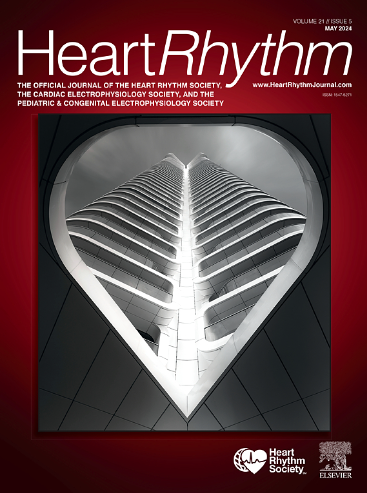Origin of ventricular fibrillation triggers in a model of localized repolarization heterogeneity
IF 5.7
2区 医学
Q1 CARDIAC & CARDIOVASCULAR SYSTEMS
引用次数: 0
Abstract
Background
Heterogeneities in ventricular repolarization contribute significantly to the genesis of ventricular fibrillation (VF). Although clinical arrhythmias are spontaneously triggered by premature ventricular complexes, these triggers are difficult to document and little is known about their site of origin.
Objectives
The purpose of this study was to characterize spontaneous VF initiation in an experimental model of repolarization heterogeneity and to identify the origin of triggers in relation to the spatial dispersion of repolarization.
Methods
Spatially limited repolarization heterogeneity was created in isolated perfused porcine right ventricles (N = 16) by local administration of pinacidil (20 μM) in a terminal branch of the right coronary artery. High-resolution optical mapping and pseudo-electrocardiography were performed under control conditions and after pinacidil perfusion.
Results
No arrhythmia occurred at baseline, but 74 VF episodes were observed in 13 hearts (82%) after pinacidil perfusion and were most often initiated by a ventricular trigger with a short coupling interval (297 ± 66 ms). Sixteen VF initiations were optically mapped in 4 hearts. Mapping showed triggers originating in all cases from the border zone between altered and normal repolarization areas where local action potential duration and repolarization time gradients were steep (15.9 and 15.8 ms/mm vs 1.5 and 3.0 ms/mm at nontrigger sites). Optical action potential traces were compatible with a phase 2 reexcitation mechanism. The subsequent VF cycles were driven by activities located in the same region.
Conclusion
This model of localized repolarization heterogeneity is able to produce spontaneous VF initiation. Our study demonstrates that VF triggers originate consistently from the border zone of repolarization dispersion.

局部再极化异质性模型中心室颤动触发器的起源。
背景:心室复极化的异质性在很大程度上导致了心室颤动(VF)的发生。虽然临床心律失常是由室性早搏复极自发触发的,但这些触发因素很难记录,而且对其起源部位知之甚少:目的:描述在复极化异质性实验模型中自发性 VF 启动的特征,并确定触发源与复极化空间弥散的关系:在离体灌注猪右心室(N = 16)中,通过向右冠状动脉末端分支局部注射吡那地尔(20 μM),产生空间有限的复极化异质性。在对照条件下和灌注蒎烷地尔后进行了高分辨率光学绘图和伪心电图检查:基线时未出现心律失常,但在泼纳西地尔灌注后的13颗心脏(82%)中观察到74次室颤发作,最常见的是由耦合间期较短(297±66ms)的心室触发引发。对 4 颗心脏的 16 次室颤触发进行了光学映射。图谱显示,所有病例的触发都源于改变和正常复极化区域之间的边界区,该区域的局部动作电位持续时间和复极化时间梯度较陡(分别为 15.9 和 15.8 毫秒/毫米,而非触发部位分别为 1.5 和 3.0 毫秒/毫米)。光学动作电位轨迹与二期再激发机制相符。随后的室颤周期由位于同一区域的活动驱动:结论:这种局部再极化异质性模型能够产生自发性室颤起始。我们的研究表明,房颤触发因素始终来自复极化弥散的边界区域。
本文章由计算机程序翻译,如有差异,请以英文原文为准。
求助全文
约1分钟内获得全文
求助全文
来源期刊

Heart rhythm
医学-心血管系统
CiteScore
10.50
自引率
5.50%
发文量
1465
审稿时长
24 days
期刊介绍:
HeartRhythm, the official Journal of the Heart Rhythm Society and the Cardiac Electrophysiology Society, is a unique journal for fundamental discovery and clinical applicability.
HeartRhythm integrates the entire cardiac electrophysiology (EP) community from basic and clinical academic researchers, private practitioners, engineers, allied professionals, industry, and trainees, all of whom are vital and interdependent members of our EP community.
The Heart Rhythm Society is the international leader in science, education, and advocacy for cardiac arrhythmia professionals and patients, and the primary information resource on heart rhythm disorders. Its mission is to improve the care of patients by promoting research, education, and optimal health care policies and standards.
 求助内容:
求助内容: 应助结果提醒方式:
应助结果提醒方式:


